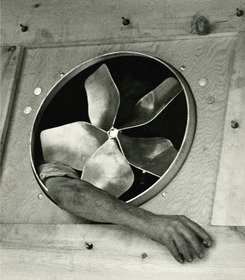Andre' Kertesz
dal 24/2/2011 al 14/5/2011
Segnalato da
24/2/2011
Andre' Kertesz
Fotomuseum Winterthur, Winterthur
Today, more than 25 years after his death, he is recognized and considered to be a central photographer of the 20th century who crucially enriched the language of photography. With around 250 photographs and countless magazine contributions, this retrospective allows a comprehensive view of his work. The chronological order and the major themes show what it is that makes up his photographic practice.

Curators of the exhibition are Michel Frizot and Annie-Laure Wanaverbecq
André Kertész (Budapest 1894–1985 New York) supported Brassaï, inspired Henri Cartier-Bresson, is considered one of the founders of photojournalism, and introduced stylistic elements into photography that can still be found in works by contemporary photographers. At heart, he was a photographer and artist in equal measure, poetic, probing, vital, independent in thought and actions. In a word, he was a master of photography, whose long period of production was very influential. Nevertheless, it took a remarkably long time for his special abilities, his poetic experimental version of photography, to find recognition in the history of photography. The three locations where he lived (Budapest, Paris, New York), his freedom, his form of “contemplative photography,” as Roland Barthes characterized it, made quick reception and categorization of his work impossible. Today, more than twenty-five years after his death, he is recognized and considered to be a central photographer of the twentieth century who crucially enriched the language of photography.
With around 250 photographs and countless magazine contributions, the retrospective at Fotomuseum Winterthur allows a comprehensive view of his work. The chronological order and the major themes show what it is that makes up his photographic practice: his unique methods (in photographic postcards, in distortions), his editorial engagement (for example, in the volume Paris vu par Kertész, 1934), his passion for experimentation (with light and shadow), and the evocation of emotions, above all of melancholy and loneliness. Periods that have remained neglected or unexplored until today (his life as a soldier from 1914-1918, for example) are reassessed, and juxtaposed with the development of photojournalism in Paris and the distribution of his pictures in the media, with which he earned his living.
André Kertész liked to characterize himself as an “eternal amateur.” But what a virtuosic “amateur” he was; what virtuosic visual language he employed his entire life to capture the poetry of the everyday! His photographic production was closely connected to his life and psyche. Even when he seemed to be documenting something, he let himself be guided almost exclusively by feeling, by instinct, from his soul. This resulted in a body of work that he liked to compare to a “visual journal”, and about which he said, “I have never just ‘made photos.’ I express myself photographically.”
The exhibition has been organized by Jeu de Paume in Paris in collaboration with Fotomuseum Winterthur.
Lecture on the André Kertész exhibition:
A double lecture, in French, will be given by Michel Frizot on Wednesday, March 30, 2011, 7.30 p.m. He will address the following two topics:
André Kertész, une économie de signes
Henri-Cartier Bresson, l’éloquence du cadre
The exhibition will travel to Martin-Gropius-Bau in Berlin, and to Magyar Nemzeti Múzeum in Budapest.
There is an comprehensive catalog accompanying the exhibition – it is also available in English: André Kertész, eds. Michel Frizot / Annie-Laure Wanaverbecq. Editions Hazan, Paris 360 pages, hardcover, 544 images. With essays by Michel Frizot and Annie-Laure Wanaverbecq. Price: CHF 69 / EUR 52 / USD 70
Until 8th May 2011:
Arbeit/Labour
Set 7 from the Collection and Archive
From its earliest beginnings, photography has captured how, where and under what conditions people work – not only by in-house photographers, adhering to the perspective and specifications of the management but also by freelance photographers with an open-ended, unfiltered approach to places of production and trade. In both content and motif, the exhibition “Arbeit/Labour” traces the transition from physical labour to automation and computer-aided work environments in conjunction with migratory movement across continents and through decades. In an exchange between applied and art photography, increasingly invisible work is shown to act as a sediment under various social circumstances.
Image: André Kertész, Arm and Ventilator, 1937. Gelatin silver print printed in the 1940s-1950s, 30,5 x 26,7 cm. Collection of Eric Cepotis and David Williams
For further information and press material, please contact
Josiane Imhasly Tel. +41 (0)52 2341060 Fax +41 (0)52 2336097 imhasly@fotomuseum.ch
Opening: Friday, 25 February 2011, from 6 p.m. till 9 p.m.
At 7 p.m., the exhibition will be introduced by Michel Frizot and Urs Stahel.
Fotomuseum Winterthur
Grüzenstrasse 44+45 , CH-8400 Winterthur (Zurich)
Hours:
Tuesday to Sunday 11 a.m. - 6 p.m., Wednesday 11 a.m. to 8 p.m., closed on Mondays
Admission:
Fotomuseum, Mark Morrisroe (Main Gallery+Gallery) Fr. 9.- (with reduction Fr. 7.-)
Fotomuseum, Arbeit / Labour (Gallery of Collections) Fr. 8.- (with reduction Fr. 6.-)
Fotostiftung Fr. 7.- (with reduction Fr. 5.-)
Ausstellungspass (all exhibitions) Fr. 17.- (with reduction Fr. 13.-)



